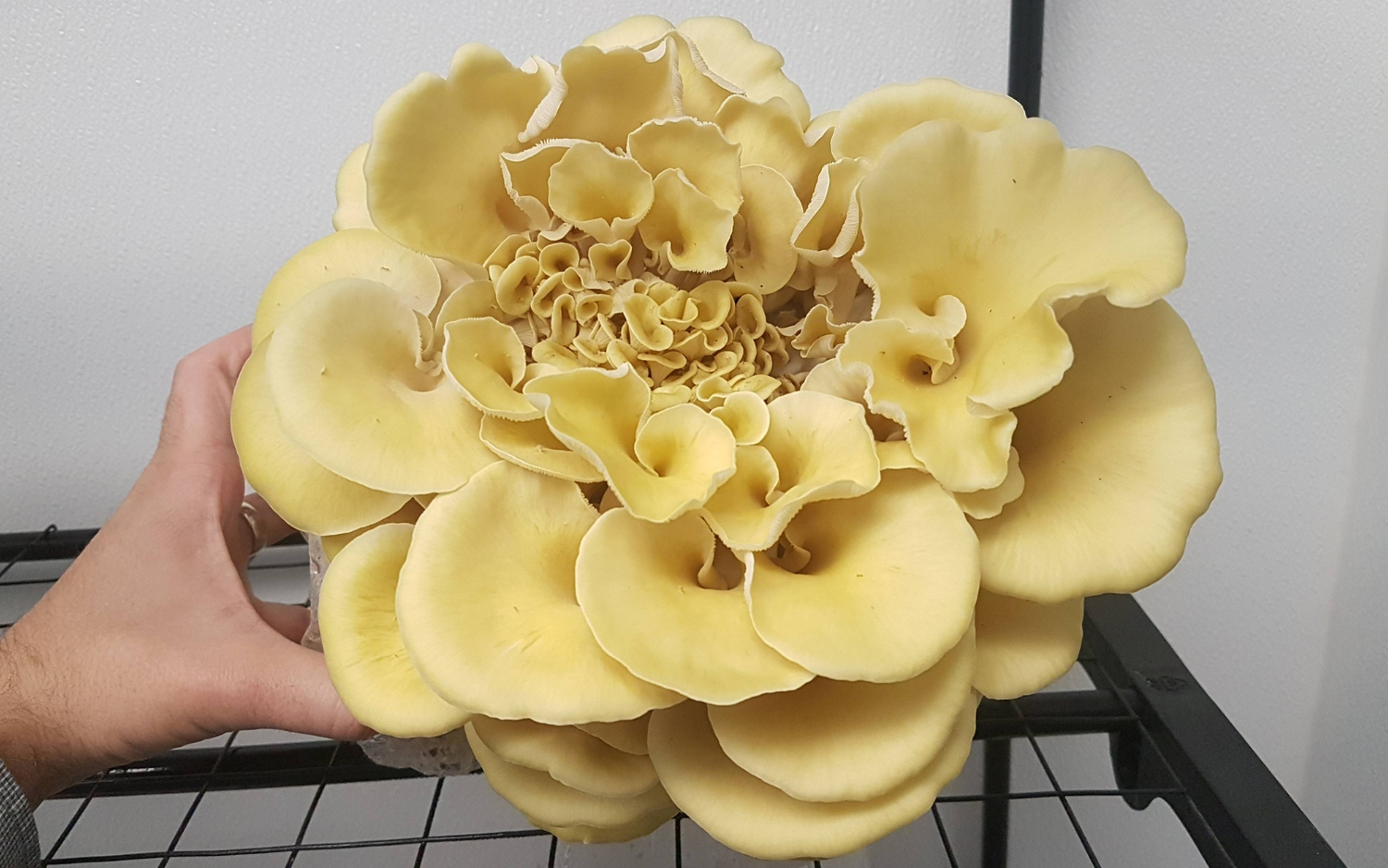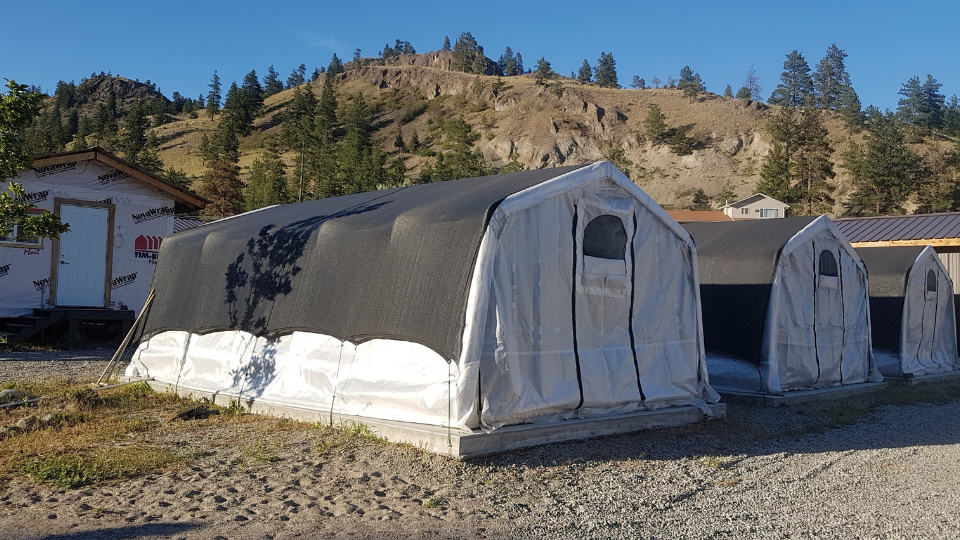One of my favorite things about being a dedicated mushroom grower is that I’m constantly learning new things. As soon as I think I have it all figured out, I’ll try something new that changes everything.
In fact, the more I learn, the more I realize that there is so much more to learn!
A perfect example of this occurred just recently, when I picked the most gigantic flush of Blue Oysters I’ve ever seen off of a 5 lb fruiting block. (almost 2 lbs!)
The thing is- this particular fruiting block wasn’t made with the standard fruiting block recipe of sawdust amended with bran. Instead, this unbelievable bounty was harvested from a 50:50 mix of hardwood sawdust and soy hulls- known by many as the “masters mix”.
As far as I know, the master behind this substrate recipe is T.R. Davis from Earth Angel Mushrooms. I first heard of it while browsing some of his videos on his YouTube, where he describes this beautifully uncomplicated substrate recipe while standing in front of some pretty impressive looking oyster blocks.
I couldn’t wait to give it a try!

THE MASTERS MIX
The masters mix is pretty straight forward:
“Combine 1 part hardwood sawdust with 1 part soy hulls, hydrate to 60%, and sterilize at 15 PSI for 2.5 hours.”
It is simply A 50/50 mix of soy bean hulls and hardwood sawdust hydrated to perfection!
To break it down even more, for every 5 lb fruiting block, you need:
- 1 lb sawdust
- 1 lb soy bean hulls
- about 3 lbs (1.4 liters) water
- 2.5 cups Hardwood Fuel Pellets
- 2.5 Cups Pelletized Soy Hulls
- 1.4 Liters of water

Why Grow Mushrooms On Soy Hulls?
So what are soy hulls and why are they so effective?
Oyster mushrooms are known to grow on just about anything… coffee grounds, sawdust, banana leaves, cotton seed hulls, and many other agricultural waste products… they all make reasonable substrates.
But some substrates are bound to produce faster growth and higher yields, and I gotta say that for Oysters, I have never seen something so effective in producing huge yields as the Master’s Mix.
Soy Hulls are just the exterior skin of Soy Beans, and are essentially a waste product of soybean farming.
For whatever reason, these soy hulls – when mixed with sawdust – have just the right nutritional composition for explosive fruiting, huge yields, and nice big fruits. It also seems to produce large and dense clusters, with endless folds of oyster mushrooms just clamoring all over each other to burst out of the bag.
You can play around with different ratios but most growers note that a 50-50 mix is ideal. Any more than 50% Soy Hulls, and your mix will be too nutritionally dense, and you will have a higher risk of contamination, or deformed mushrooms. Using less than 50% will diminish expected yield due to insufficient nutrition.
Pelletized Soy Hulls
Unless you live in a rural area and have direct access to a soy farm, you are most likely to find soy hulls in pelletized form, commonly sold as a nutritional supplement in horse feed. I can’t confirm what the horses think, but I can tell you that mushrooms sure love them! Pelletized Soy Hulls are relatively cheap, and should be easy to find at any agricultural feed store. You might even be able to find them online. These rock-hard pellets are not as easy to break up as hardwood fuel pellets- which naturally break apart as soon as you add water- so you are best off to soak them in water overnight, which makes them easy to mix with sawdust. The soy is quite sticky and gooey, so be prepared to make a bit of a mess.
Making Soy Hull Fruiting Blocks
Using the recipe described above, follow these steps to grow mushrooms on soy hulls with awesome results every time:STEP 1: Soak the Soy Hulls
Soak the hulls in the appropriate amount of water, which is about 700ml for every 2.5 cups of pelletized hulls. It’s best to soak the hulls overnight so that they get a chance to break up. You can also use boiling water which will allow the soy hulls to break up a lot faster, although you’ll still need to loosen them up with your fingers if you want to use them right away.STEP 2: Hydrate the Fuel Pellets
Add 700ml of water to the fuel pellets until they are evenly broken up. Using hot water can speed this process up significantly. If you use cold water, just use your fingers to break up all the pellets into a nice even sawdust.STEP 3: Mix and Sterilize
Mix the hydrated soy pellets and hardwood sawdust thoroughly and pack into a large autoclavable mushroom grow bag. Fold over the top of the bag and pressure sterilize at 15PSI for 2.5 hours. I am sure that you can get away with a shorter sterilization time, but I have not experimented with this too much. I like to play it safe, and 2.5 hours will be sure to kill whatever contamination might be lurking in your substrate.STEP 4: Inoculate, Colonize and Fruit
Inoculate each 5 lb block with around 1 quart of your favorite oyster mushroom spawn. I have tried both Blue Oysters and Yellow Oysters on this mix and they both performed fantastically. Once colonized, you can fruit by cutting off the entire top of the bag, or by cutting a slit across the side of the block and laying it on its side. Sometimes the block will start to pin heavily on top of the block before you are ready to fruit it. If this is the case, then simply cutting off the top of the bag is the way to go.


